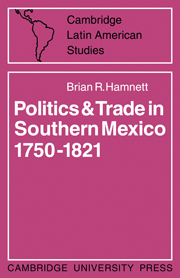Book contents
- Frontmatter
- Contents
- Acknowledgments
- Archival abbreviations
- Weights, measures, and currency
- Introduction
- 1 Oaxaca—environment and trade
- 2 The struggle for control of trade
- 3 The problem of reform, 1768–1786
- 4 Reform and reality—the crisis of the subdelegations in the 1790s
- 5 The Gálvez Plan under fire, 1786–1804
- 6 Finance, trade, and the merchants, 1789–1808
- 7 The political crisis of 1808–1821
- 8 Conclusion—Oaxaca within the context of Mexican politics
- Glossary of Personnel
- Appendices
- Sources and bibliography
- Maps
- Index
- Frontmatter
- Contents
- Acknowledgments
- Archival abbreviations
- Weights, measures, and currency
- Introduction
- 1 Oaxaca—environment and trade
- 2 The struggle for control of trade
- 3 The problem of reform, 1768–1786
- 4 Reform and reality—the crisis of the subdelegations in the 1790s
- 5 The Gálvez Plan under fire, 1786–1804
- 6 Finance, trade, and the merchants, 1789–1808
- 7 The political crisis of 1808–1821
- 8 Conclusion—Oaxaca within the context of Mexican politics
- Glossary of Personnel
- Appendices
- Sources and bibliography
- Maps
- Index
Summary
On to the indigenous civilisations of the Zapotecs and Mixtecs, the Castilian conquerors grafted the political and religious experience of Spain. The Aztec outpost of Huaxyacac became the centre of Spanish power and influence in the fertile Valley of Oaxaca. Through the course of the later sixteenth and seventeenth centuries, many of the indigenous areas of the province of Oaxaca fell under the spiritual control of the Dominican Order, which, from its Baroque convents and churches, exercised a theocratic authority that virtually excluded the power of the Crown. The Crown's authority emanated from the capital, the city of Antequera de Oaxaca, named after Antequera in Andalusia, which it was supposed to resemble; but in these religious centuries, often the authority of the Bishop of Oaxaca evoked a more immediate response in consciences.
Oaxaca was one of the main centres of Spanish power in the colonial period, a power whose bases were fixed more firmly into the centre and south of New Spain than in the modern Mexican Republic, which tends more strongly to the north and north-centre. The colonial Oaxaca was a region comparable with Guatemala, with Quito, and the highland regions of Peru, centres where Castilian authority influenced and permeated already well-formed indigenous cultures, and where, gradually, not without resistance, and often by means of symbols and demonstrations, the religion brought by the friars exercised a mystical fascination for the former subjects of the Aztecs, Mayas, or Incas.
- Type
- Chapter
- Information
- Politics and Trade in Mexico 1750–1821 , pp. 1 - 8Publisher: Cambridge University PressPrint publication year: 1971

